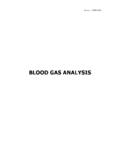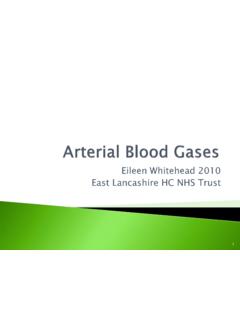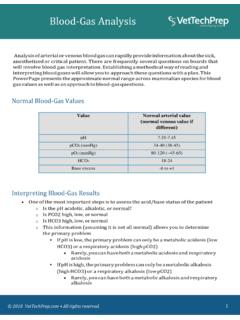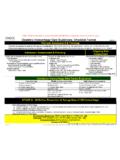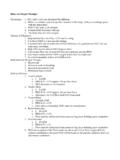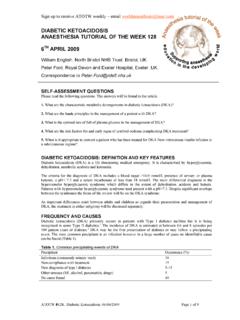Transcription of 205 The effects of anaesthesia on respiratory function - FRCA
1 Sign up to receive ATOTW weekly - email ATOTW 205 The effects of anaesthesia on respiratory function , 15/11/2010 Page 1 of 8 THE effects OF anaesthesia ON respiratory function anaesthesia TUTORIAL OF THE WEEK 205 15TH NOVEMBER 2010 Dr Rachel Davison, FRCA Dr Daniel Cottle, FRCA North West Deanery School of anaesthesia Correspondence to QUESTIONS 1. The following are true or false: a: Airway patency can be lost without the use of muscle relaxants. b: Sevoflurane causes an increase in saliva production. c: Propofol causes a loss of the cough reflex. d: Saliva on the vocal cords can cause laryngospasm. e: Ketamine causes an increase in saliva production. 2. End-tidal carbon dioxide: a: Corresponds to the arterial oxygen partial pressure. b: Is inversely proportional to the alveolar ventilation. c: Is raised after the administration of opioids. d: Is reduced if the cardiac output is significantly reduced. e: Can confirm the tracheal placement of an endotracheal tube.
2 3. Ventilation: a: Is reduced by in the presence of an acidaemia. b: Is controlled only in the brain stem. c: Is stimulated by hypoxia. d: Is significantly impaired when using ether e: Is unaffected by the use of isoflurane. 4. Hypoxia: a: Can always be corrected by increasing the inspired oxygen concentration. b: Can be caused by airway obstruction. c: Can not be prevented when inducing anaesthesia . d: Is caused by shunt when small airways collapse. e: Is made worse by hypoxic pulmonary vasoconstriction. 5. The following are true or false: a: When the airway is obstructed, the main oxygen reserve is within arterial blood. b: The FRC is reduced by abdominal distension. c: Is greater than the closing capacity in an 80 year woman with COPD. d: Can be filled with oxygen by breathing 50% oxygen. e: A patient with a BMI of 35 breathing 100% oxygen will de-saturate faster than a patient with a BMI of 22. Sign up to receive ATOTW weekly - email ATOTW 205 The effects of anaesthesia on respiratory function , 15/11/2010 Page 2 of 8 INTRODUCTION The primary functions of the respiratory system are: 1.
3 Ventilation; the movement of air into and out of the lungs. 2. Gas exchange; the transfer of oxygen into the blood and the removal of carbon dioxide. General anaesthesia has a number of effects on both of these key functions . The passage of gas into the lungs may be impaired by obstruction of the airway; the drive to ventilation may be reduced or cease altogether; the distribution of gas within the lungs may change and the transfer of oxygen (and anaesthetic gases) into the blood may be impaired. Most of these adverse effects can be seen during anaesthesia and in many patients these extend into the post-operative period. This tutorial will explain how anaesthesia affects the respiratory system and how these effects can be managed. HOW anaesthesia AFFECTS VENTILATION 1. Airway obstruction General anaesthesia , with or without the use of neuromuscular blocking drugs, results in the loss of airway patency due to the relaxation of the pharyngeal muscles and posterior displacement of the tongue.
4 The ability to manage secretions is lost, and saliva and mucous can obstruct the oropharynx. The loss of the cough reflex allows secretions (or refluxed gastric contents) onto the vocal cords, causing laryngospasm, or to enter the trachea and lungs causing bronchospasm and ultimately infection. These effects result in airway obstruction and prevent the passage of gases into and out of the lungs resulting in hypoxia and hypercapnia. 2. Reduced ventilation Carbon dioxide diffuses rapidly from the blood into the alveoli, from where it is removed by ventilation. These events give rise to two key principles: 1. The partial pressure of carbon dioxide in the alveoli (PACO2) is the same as the partial pressure of carbon dioxide in arterial blood (PaCO2). 2. The PaCO2 is ventilation dependent ; as alveolar ventilation increases more CO2 is excreted and the PaCO2 falls. Conversely, a reduction in alveolar ventilation causes an increase in PaCO2.
5 The first principle allows us to use PACO2 as an indirect measure of PaCO2. This is done by sampling the expired gas and measuring the expired CO2. The gas at the end of expiration is the closest to pure alveolar gas. We call this the end-tidal CO2 or PetCO2. The second principle allows us to use PetCO2 as a measure of ventilation because the PetCO2 will change in the same direction as the PaCO2. All anaesthetic drugs (except ketamine, ether and nitrous oxide) cause a dose- dependent reduction in ventilatory minute volume. This can be due to either a reduction in the respiratory rate ( opioids), a reduction in the tidal volume ( volatile anaesthetics) or both ( propofol). As alveolar ventilation decreases the PaCO2 increases. Hypercapnia causes vasodilation, tachycardia, arrhythmias, hypertension and in an awake patient, headache, confusion, tremor, sedation and eventually coma (CO2 narcosis). Of equal importance is that the increased PACO2 displaces oxygen from the alveoli and can exacerbate hypoxia.
6 All of these effects can be seen in the postoperative period. Under normal conditions the PaCO2 of arterial blood is the predominant factor controlling ventilation. Any increase in PaCO2 is detected by peripheral (carotid bodies) and central (medullary) chemoreceptors. As a result there is a linear increase in ventilation of approximately 2 l/min for each kPa (1 mmHg) rise in PaCO2. The pH (or hydrogen ion concentration) of the blood also has an effect . Acidaemia stimulates ventilation via the peripheral chemoreceptors. This ventilatory response to carbon dioxide is reduced by virtually all anaesthetic drugs (the main exception being ether) until excessively high concentrations are produced. As a result, anaesthetised patients become hypercapnic. Sign up to receive ATOTW weekly - email ATOTW 205 The effects of anaesthesia on respiratory function , 15/11/2010 Page 3 of 8 In addition, anaesthetics have two further undesirable effects on ventilation; firstly after a period of mechanical ventilation the threshold at which the PaCO2 stimulates the return of spontaneous ventilation is increased, thus delaying the return of spontaneous ventilation and secondly, the ventilatory response to acidosis is blunted, reducing a patient s ability to compensate.
7 Hypoxia also effects ventilation. When the arterial oxygen concentration (PaO2) falls to less than 8 kPa (60 mmHg), the carotid and aortic body chemoreceptors increase minute ventilation and cardiac output through sympathetic nervous system stimulation. Anaesthetic drugs reduce this normal protective response to hypoxia, with volatile drugs having an effect at concentrations as low as MAC (Minimum Alveolar Concentration). Clearly as patients recover from anaesthesia , low concentrations of a volatile drug last several hours into the post-operative period, putting them at risk of hypoxaemia. HOW anaesthesia effects GAS EXCHANGE The second key function of the respiratory system is gas exchange. Oxygen is the gas of primary importance, but the exchange of anaesthetic gases will also be influenced. Oxygenation is dependent upon: the inspired oxygen content the presence of a patent airway adequate alveolar ventilation appropriate matching between ventilation and perfusion in the lung the transfer of oxygen across the alveolar and endothelial membranes.
8 We have already looked at airway obstruction and hypoventilation, but anaesthesia also has other effects that reduce oxygenation. 1. Changes in functional residual capacity (FRC) a. Oxygen content of FRC The volume of gas in the lungs at the end of normal expiration is the functional residual capacity (FRC), approximately 3000ml in a 70kg man. ERV = Expiratory Reserve Volume, the volume that can be forcibly expired at the end of normal expiration RV = Residual Volume, the volume left in the lungs at the end of maximal expiration The oxygen in the FRC is the lung s store of oxygen. Increasing the oxygen concentration of the inspired gas increases the proportion of oxygen in the FRC and hence increases the time taken for a patient to become hypoxic when ventilation stops. (Breathing air, 21% of 3000ml = 630ml oxygen. Breathing 30% oxygen, 30% of 3000ml = 900ml oxygen). Preoxygenation (a high inspired oxygen content for several minutes/breaths before induction of anaesthesia ) allows the FRC to act as a reservoir of oxygen and may prevent hypoxia for up to three minutes in a patient with normal lungs and oxygen consumption.
9 B. Volume of the FRC The FRC is approximately 3000ml when upright but falls to around 2200ml in a supine position due to upward pressure from abdominal contents. General anaesthesia relaxes the diaphragm and intercostal muscles, with a further fall in FRC by 15-20% (approx 450ml). In addition, FRC is reduced by obesity, pregnancy, bowel distension or reduced alveolar volume due to atelectasis, consolidation or oedema. Therefore, an obese, supine patient may have reduced the volume of their FRC by 50%. This reduction in the store of oxygen will reduce FRC = ERV + RV Sign up to receive ATOTW weekly - email ATOTW 205 The effects of anaesthesia on respiratory function , 15/11/2010 Page 4 of 8 the time taken to become hypoxic after ventilation ceases. c. Relationship to closing capacity (CC) CC = the lung volume at which small airways collapse, impeding flow of gas into the alveoli, Usually FRC exceeds CC and prevents collapse during normal expiration.
10 However, during anaesthesia the CC approaches the FRC producing small airway collapse in normal expiration with resultant atelectasis. This effect is also compounded in neonates, the elderly, smokers and patients with respiratory disease. CT imaging of the thorax during anaesthesia , demonstrates this effect in up to 80% of patients. 2. Changes in ventilation and perfusion In an ideal lung, the distribution of gas in the alveoli (ventilation, V) would be exactly matched by the distribution of blood flowing through the pulmonary capillaries (perfusion, Q). However, during inspiration, a greater proportion of the inhaled volume is distributed to the non-dependent areas at the top of the lung. Unfortunately, the effects of gravity reduce pulmonary blood flow in this region. As a result there is a degree of unevenness between ventilation and perfusion, usually referred to as ventilation-to-perfusion (V/Q) mismatch ; the better-ventilated alveoli are under-perfused.










